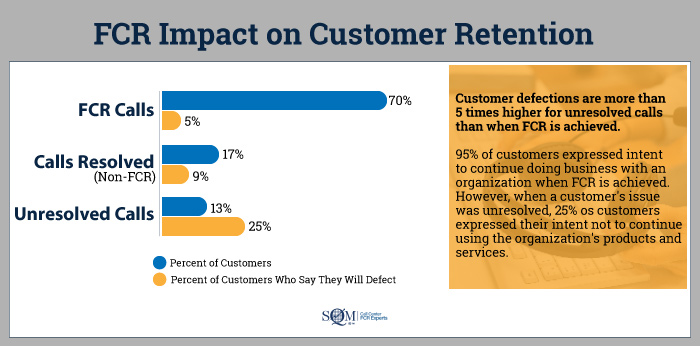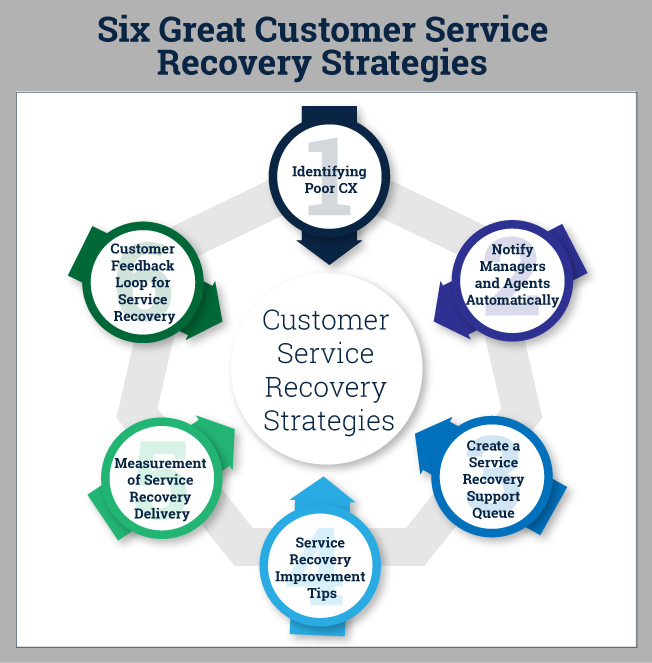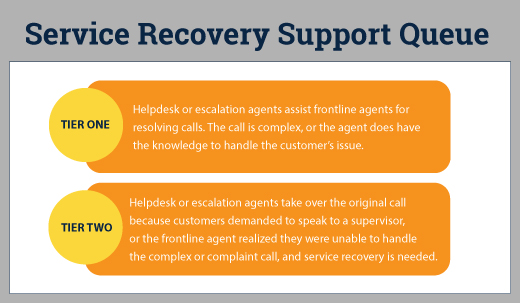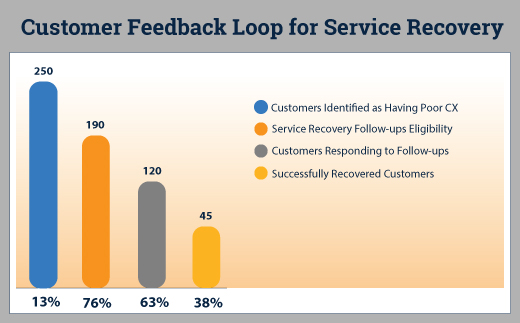Leadership Buy-in for Service Recovery
Before you read about what is and the importance of service recovery and strategies for improving it, we wanted to share our thoughts about the need for leadership buy-in to deliver great service recovery. It has been SQM Group's experience that leadership buy-in is critical to access the necessary resources and support required for a successful service recovery program.
For a call center wanting to invest in a service recovery program initiative, it's important to get leadership buy-in by showing them the business case for improving the company brand image, customer retention, and increasing revenue resulting from a successful service recovery program. Therefore, most call centers have a strong business case to invest in a service recovery program.
This blog focuses on six great customer service recovery strategies to use after a poor CX. Designing and implementing service recovery strategies requires leadership buy-in and long-term commitment for them to be successful.

Unfortunately, SQM research shows that only 5% of call centers provide world-class service recovery. Therefore, we would describe most call centers with a service recovery program as somewhat effective but not great. For example, the average call center service recovery Csat (top box Csat survey response) is 47% versus world-class call centers; the Csat average is 77%.
What Is Service Recovery?
Service recovery refers to a call center agent providing a solution for handling a customer complaint or poor customer service experience. For great service recovery to occur, a call center must design people, processes, policies, and technology to assist agents in delivering the best service recovery possible.
Importance of Service Recovery?
According to SQM research, 14% of customers who phoned a call center would define the reason for their call as a complaint they have with the company's product or service. Many call center managers are surprised to discover that such a high number of customers would describe their contact reason as a complaint call.
Furthermore, 88% of customers have stopped doing business with a company because of poor call center customer service. Therefore, service recovery aims to convert dissatisfied customers to satisfied ones, so they will likely continue using a company's products and services.
It is not uncommon for customers to defect after just one poor call center experience. In addition, SQM research shows for the call center industry that the average transactional Net Promoter Score® (NPS®) for complaint callers where no service recovery was provided the NPS is -16%, versus complaint callers where service recovery took place the NPS® is 45%.
"It takes 20 years to build a reputation and five minutes to ruin it. So if you think about that, you'll do things differently" – Warren Buffett. Given the high percentage of complaint callers and that 29% of customers have to conduct two or more calls to resolve the same inquiry or problem, it is no wonder that improving service recovery has become so important.
95% of customers expressed intent to continue business with an organization when First Call Resolution (FCR) is achieved. Many enlightened leaders believe that the call center's primary purpose is to retain customers by providing FCR. Therefore, call center leaders should measure and track their FCR and correlate it to customer retention.
Furthermore, the data shows only 5% of customers expressed their desire to stop doing business with a company when FCR is achieved. However, when it took two or more calls to resolve an inquiry or problem, 9% of customers expressed their intent to defect. Also, 13% of calls are unresolved, and in most cases, call center employees do not know which customers' call goes unresolved. What is alarming about that is when a customer's issue was unresolved, 25% of those customers said they intended not to continue using the organization's products and services.

For most call centers, service recovery represents one of the essential practices for this business unit to have a tremendous positive impact on helping improve the company's brand and financial performance. The main reason is, in most cases, the call center is the last line of defense from customers defecting to their competition.
Six Great Customer Service Recovery Strategies to Use After a Poor CX
Given that call centers are the last line of defense, they are responsible for recovering and strengthening the customer relationship when they have a negative experience. In many cases, call center service recovery does exist. However, leadership may fail to realize the great potential service recovery opportunities to strengthen the customer relationship and increase revenue and profits.
For a call center to maximize service recovery opportunities comes down to identifying customers who had a poor CX, capturing customer feedback, understanding the CX, and acting on the CX to provide great service recovery. So, it's time to focus on six great customer service recovery strategies to use after a poor CX:

1. Identifying Poor CX
Many call centers are not effective at identifying poor customer experience. When conducting agent interviews and asking them how they define poor CX or a customer complaint, it is always an inconsistent definition. The inconsistency in defining poor CX or customer complaints is problematic for call centers to deliver great service recovery consistently.
Furthermore, because call centers do not have a complaint call definition, or even if they do, it is interpreted inconsistently by agents, it is no surprise that they are inconsistent in identifying, tracking, and resolving customer complaint calls.
There are many ways to consistently identify poor CX or a customer complaint, such as developing a complaint definition, training agents on identifying a complaint, and monitoring agents' ability to identify a complaint through the quality assurance program. In addition, post-call surveys and sentiment analysis using speech analytics can be an effective way to identify poor CX or a customer complaint. Also, companies need to follow social media sights such as Facebook, Linkedin, TikTok, and Twitter to identify poor CX or customer complaints.
2. Notify Managers and Agents Automatically
Negative customer feedback should be automatically sent to the appropriate manager and or agent based on agreed-upon criteria for a poor CX (e.g., customer dissatisfaction survey rating, unresolved call, speech recognition sentiment analysis showing an upset, dissatisfied, or angry customer).
Poor CX alerts come from a customer service QA or CRM software. The poor CX creates a service recovery notification ticket prompting a manager or agent to review a customer call recording, screen shoots, survey rating, and sentiment analysis to gain insights on the customer's situation that resulted in a negative experience.
For negative customer feedback notifications to be effective, they should be identified in real time or, at minimum, within 24 hours of the customer interaction. Furthermore, whether the manager or agent conducts the outbound call or email with the customer, they need to be held accountable for reaching out to a customer within one day of the interaction for service recovery.
3. Create a Service Recovery Support Queue
Once you have identified poor CX and the service recovery notification criteria, it is crucial to decide who will be responsible for acting on the notification tickets. Helpdesk or escalation agents are the service recovery support queue for many call centers that are responsible for acting on service recovery tickets.
It is common for this queue to handle customer calls from the frontline agent asking for assistance versus the customer calls being transferred to them, or they make an outbound call to provide service recovery. In most cases, they are a reactive support queue versus a proactive support queue that reaches out to customers with an outbound call or email to provide service recovery.
Traditionally, the helpdesk or escalation support queue has two tiers of agents:
Tier 1 helpdesk or escalation agents assist frontline customer service agents with resolving their customer calls and are not in direct contact with the customer. In other words, they act as an internal helpdesk for frontline agents.
Tier 2 helpdesk or escalation agents handle complex, or complaint calls by having the frontline agents transfer the call to them to resolve the customer's call directly. Again, the majority of service recovery calls are a reactive approach for handling poor CX.

The customer recovery support queue agents play a vital role in supporting agents in resolving calls or handling complex calls. For many organizations, the call center helpdesk or escalation service recovery queue agents are the last line of defense for providing First Call Resolution, great customer service, and retaining customers.
4. Service Recovery Improvement Tips
The service recovery agent improvement tips to help resolve customer complaints and complex calls. To help improve poor CX, here is a list of service recovery agent improvement tips:
- Service recovery agents treat a customer complaint as a gift because they get a chance to recover from the complaint
- The use of a two-tier service recovery team structure to support frontline agents and recover from poor CX
- The frontline agent-to-service recovery agent support ratio should be 15:1
- Service recovery agents are available in real-time and are dedicated to supporting frontline agents
- If cost is an issue, create a service recovery agents queue by areas such as key lines of business, or valuable customers
- The fulfillment department has a reporting relationship with the call center
- There is a complaint definition, agents identify and document a complaint in the CRM, and complaint calls are analyzed for improvement opportunities
- There are efficient and effective scripts, KMT, and CRM tools for assisting service recovery agents in resolving calls
- Service recovery agents treat frontline agents as internal customers and are held accountable for supporting them in resolving calls
- When a frontline agent feels that the customer is going to defect from the company or the customer expresses the intent to leave, the customer is transferred to the service recovery agent
- Use service recovery calls to identify where the areas are to improve FCR and Csat performance
5. Measurement of Service Recovery Delivery
The best way to determine a call center's service recovery delivery effectiveness is to measure it. Very few call centers measure service recovery support queue performance from a customer's point of view, using metrics such as FCR, calls resolved, or Csat. In other words, let the customer be the judge of whether the call was resolved and whether poor CX service recovery took place. Here is a list of call center metrics SQM recommends as a best practice for measuring, benchmarking, trending, reporting, and actioning calls handled in your service recovery support queue:
- Number and percent of customers identified as having poor CX
- Number and percent of service recovery follow-ups eligible
- Number and percent of customers responding to follow-ups
- Number and percent and successfully recovered customers
- Percent of complaint callers
- Percent of complaints resolved in one call (FCR)
- Percent of service recovery calls where Csat was top box survey response
- Percent of complaint callers resolved
- Average complaint resolution time
- Percent of unresolved complaints
- Cost of customer complaints
- Complaint call type reasons and percentages
- Complaint root causes (e.g., people, processes, policies, products, and pricing)
- The complaint calls impact on company Csat and retention
- Frontline agents' satisfaction with service recovery agents' support
6. Customer Feedback Loop For Service Recovery
Again, it's important to emphasize that every poor CX negatively impacts the brand image, and customers defect from doing business with the company if they have a choice. Reducing poor CX impact on the company's image and financial performance requires measuring service recovery delivery. As the old adage saying goes – you can not improve it unless you measure it.
The below infographic shows an example of a customer feedback loop for service recovery management, which entails identifying customers as having poor CX, service recovery follow-up eligibility, responding to follow-ups, and successfully recovering customers. Our mySQM™ Customer Service QA software feature includes a customer feedback loop for service recovery metrics for assessing the number and percentage of customers for the four key metrics for managing the service recovery program.
One of the biggest challenges for call centers is to identify customers who have poor
CX. Many call centers use post-call surveys and speech analytics to identify poor CX. Service recovery follow-ups are based on eligibility criteria such as customer dissatisfaction, unresolved calls, and sentiment analysis. Customers responding to follow-ups are based on a call center employee who was able to discuss the poor CX and provide potential solutions to remedy the customer issue. Successfully recovered customers are typically based on customer satisfaction and call resolution.

Note: How the percentages are determined. 13% is the number of customers who called the center that had poor CX. 76% is dividing the # of recovery follow-ups by the # customers who had a poor CX. 63% is dividing the # of customers responding to follow-ups by the # recovery follow-ups. 38% is dividing the # of recovered customers by the # responding follow-ups.
Quick Related Links
First Call Resolution Comprehensive Guide Customer Satisfaction Comprehensive Guide Customer Feedback Loop Post-Call Survey Good to Great Customer Service
